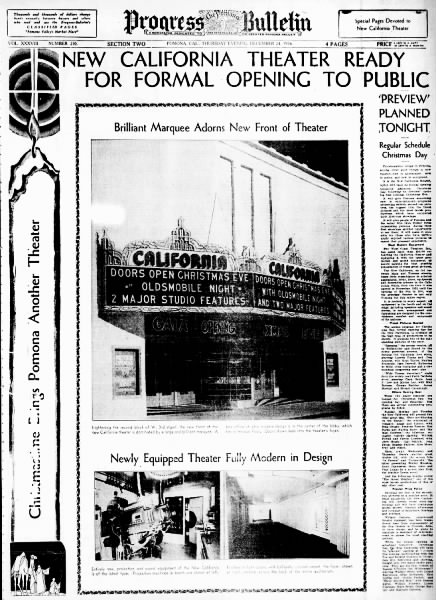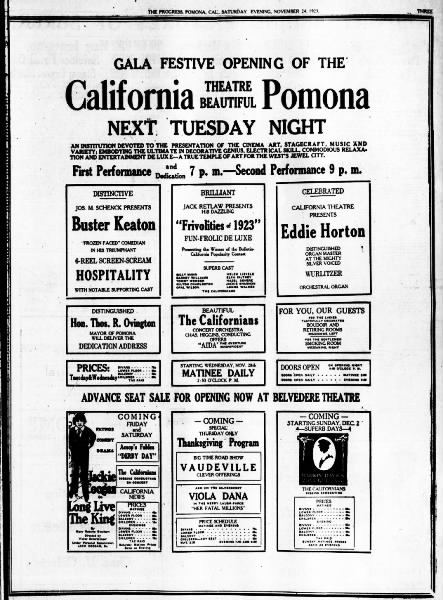
Pomona Valley Auditorium
235 W. 3rd Street,
Pomona,
CA
91766
235 W. 3rd Street,
Pomona,
CA
91766
![]() 3 people
favorited this theater
3 people
favorited this theater
Showing 1 - 25 of 29 comments
Replying to Joe Vogel: This theater had a true balcony. There were two “L” shaped staircases that led from the ground floor lobby up to the balcony lobby. When first opened, this theater was accessed through the adjacent building to the right. Here is a link from around 1926: https://content.ci.pomona.ca.us/digital/collection/Landmarks/id/2512/rec/102 In the picture, you can see the old facade of the auditorium section (which is the smaller darker building to the left) is flat and flush. That is where the long skinny back lobby portion was. It was very plain and drab because it was not the main entrance. Sometime in the 30s, the marque and entrance was moved around the corner to where the two exits are. In a nutshell, I’m trying to say that the two side exits were for egress for all patrons. The balcony patrons had to come down the staircases to the main lobby before exiting the theater. I know this for a fact as I snuck in as a kid to explore. At that time, the theater was being remodeled again in order to become the Pomona Valley Auditorium.
Reopened as the United Artists theatre on December 2nd, 1949. Another grand opening ad posted.
This closed in 1932 and reopened on December 24th, 1936. Another ad posted. Fox California opening 24 Dec 1936, Thu The Pomona Progress Bulletin (Pomona, California) Newspapers.com
Fox California opening 24 Dec 1936, Thu The Pomona Progress Bulletin (Pomona, California) Newspapers.com
This opened as the California theatre on November 27th, 1923. Grand opening ad posted. California theatre opening 24 Nov 1923, Sat The Pomona Progress Bulletin (Pomona, California) Newspapers.com
California theatre opening 24 Nov 1923, Sat The Pomona Progress Bulletin (Pomona, California) Newspapers.com
I began my theatre career at United Artists Pomona in 1966, where I met my wife, Sherry, who was a cashier for Mr. Walcott, the manager. Since I was hanging around the theatre so much, Mr. Walcott put me to work as the marquee boy to replace Rusty, who went to Vietnam. Mr. Walcott had a prosthetic leg and would have to carry the film upstairs one reel at a time. He was an old time performer who would entertain the staff during slow times by actually hypnotizing some of the employees. When Mr. Walcott became ill, he was replaced by Charles McCann, who managed for a few years longer. Elderly Mr. McCann would bring his equally elderly wife to work with him, and she would sew the torn masking and drapes in the building. He was dismayed that the company (UA) did not show enough appreciation for his wife’s efforts. We fondly remember some of the employees from those times — Mr. and Mrs. Deem, Carol Deem, and Linda Marshall. The projectors were carbon arc and there were a series of ancient dressing rooms under the stage which were definitely haunted. I’m 65 now and my wife and I are still, happily, in the theatre business.
Also in Pomona:
American Theatre — 470 W. 2nd
It’s in the 1919/20 and 1923/24 city directories. In the classified section for 1923/24 it’s listed as an Ontario address, but obviously a mistake. There’s no listing for 1926.
Several Pomona theatres I don’t see listings for:
La Pictoria 478 W. 2nd St.
— in the 1912/13 and 1914 city directories
Lyric Theatre 366 W. 2nd St., Pomona
— in the 1912/13 through 1926 city directories
Fraternal Aid Opera House ne corner Gordon & 3rd, Pomona
— in the 1912/13 and 1914 city directories
I see Sammie Girl was asking about the Lyric in 2008.
I think this was a church when I was out there a while ago.
Here is a March 1970 ad from the Pomona Progress-Bulletin:
http://tinyurl.com/ykjqrpo
Here is a 1970 photo from the LAPL:
http://jpg1.lapl.org/00080/00080198.jpg
Here is an item in Boxoffice magazine, April 1950:
POMONA, CALIF-Bob Helm has been appointed manager of the United Artists Theater, replacing Gordon Goodloe, who was transferred to the Loew’s State Theater in Los Angeles. Mr. Goodloe served three years with Fox West Coast theaters prior to his war service. He came to Pomona after his discharge in 1946, and was the first manager of the Sunkist, later the State and finally the California Theater, which was taken over by the United Artists chain, remodeled and named the United Artists. Helm had been the manager of the Capitol Theater in Glendale until his promotion.
Pics of flyers from PVA shows:
View link
View link
View link
Oh, heck, this was the Pomona Valley Auditorium?? Been there soooo many times to see concerts…lol, didn’t know that the California Theater and the PVA were one and the same.
Does anyone have any info on the Lyric or American Theaters in Pomona? Cinema Tour has them both listed simply as closed, but no other info on them.
Cinetour had the California listed as the California Fox and also known as the United Artists Theater on 3rd in Pomona…same place?
Pomona Public Library has these pics:
View link
View link
View link
View link
View link
Pomona Public Library had this photo listed as California Theater in Pomona
View link
I think we agree that the status is closed as opposed to closed/demolished.
I’ve only ever seen the end exits on the fronts of those few older theatres that had stadium sections, such as the Rialto on Broadway and the Monterey (nee Mission) in Monterey Park. It’s possible that some theatres with ordinary balconies also had such exits from the balcony to the front of the building, but I’ve never seen one. My guess would be that the “balcony” advertised in LoopNet’s listing of Bowling Green’s State Theatre is more likely a stadium section.
This configuration is pretty rare. I’ve only ever been to three theatres with such stadium sections, and only two of those (the Rialto and Monterey) had the end exits on the front. Both of these houses had two cross aisles- one at the top of the passages leading into the theatre, and a second across the middle of the stadium section. The stairs leading down to the front end exits were accessed from the upper cross aisle.
The third theatre with a stadium section that I attended was the Whittwood in Whittier, a post-war theatre in which there was only one cross aisle, and the stairs were entirely internal, leading up from the lobby and providing the access to both the stadium section and the orchestra floor.
Joe, here is a loopnet photo that Lost Memory posted for the State Theater in Bowling Green. As you can see, the exits are also in the front. I was curious to know from your comment if this was an unusual architectural feature.
http://tinyurl.com/4vmxx7
Wow, end exits on the front of the building. I wonder if they served a regular balcony or a stadium section? Most often, on theatres I’ve seen, such end exits indicate stadium seating at the back of the auditorium.
Here are some photos:
http://tinyurl.com/4ob57d
http://tinyurl.com/46ljkq
http://tinyurl.com/4fgce3
The L.A. County Assessor’s Office Parcel Viewer (not as slick as the city’s ZIMAS system, but serviceable for properties outside the City of Los Angeles) gives the following information for the building at 235 W. 3rd St. in Pomona: it is only one structure, 13,940 sq. ft., built in 1923, with the effective year built being 1963. “Effective year built” means either a major addition to or a major rehabilitation of the building dates from that year. The California is not demolished, then, but has undergone major alteration.
I might be out there tomorrow. I will check it out.
When I visited the Fox Pomona Theatre with the Theatre Historical Society in 2005, several of us walked down the street, having had the United Artists Theatre building pointed out to us. We could see the stagehouse mentioned above, and, as someone with knowledge of Egyptian architecture, I can say that indeed there are remnants of Egyptian style on the facade, albeit slight. There is what is known as a cavetto cornice running along the top, and a cylindrical torus molding along the top and down the sides. As I recall, the facade “leans” in slightly, in what in architecture is called a “battered” wall.
Jeff;I have to say you ‘could’ be correct. Maybe the fire I reported was not that great. Unfortunately, I can’t remember where I sourced that information from. Can someone local ask around or ask someone in the building if they remember and if it’s the same as the theatre building.
Wayne;‘the rather stark interior’ you mention could be the result of re-furbishment over the years.